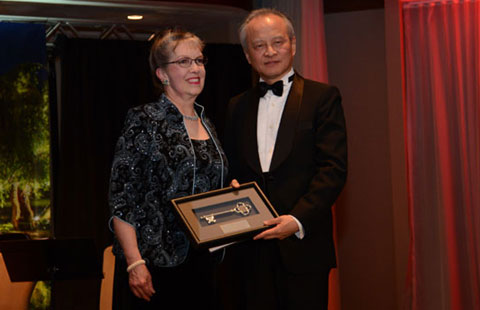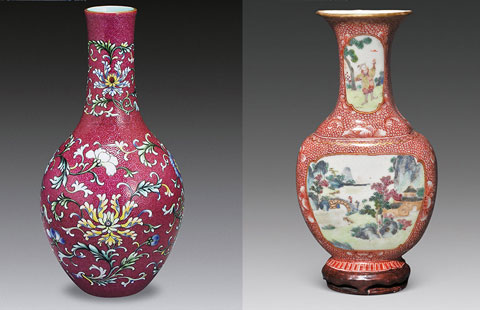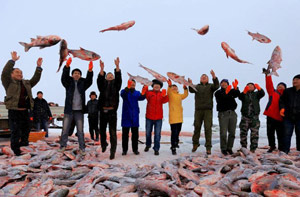Geo-economic strategy for Eurasia
Updated: 2014-06-19 07:07
By Liang Qiang(China Daily)
|
||||||||
Vision of a Silk Road economic belt needs a detailed top-level design to guide its actual effects and ensure tangible benefits
In September 2013, Chinese President Xi Jinping proposed that China and Central Asia join hands to build a Silk Road economic belt, which would not only include all China's strategic partners in the Eurasian region, but also cover the whole of Eurasia. Such an economic belt would be the world's longest economic corridor with the most potential for development and a strategic base of energy resources in the 21st century.
In his 2014 government work report, Premier Li Keqiang said that China will intensify the planning and building of a Silk Road economic belt and a 21st century maritime Silk Road. Until now, the authorities of Kazakhstan, Uzbekistan, Kyrgyzstan and Ukraine have all expressed support for the vision, while other countries have not yet given an official response and there are even some negative views about the vision in Russia. There are several reasons for such different reactions from different regional countries.
First, Russia and the United States have put forward similar plans in the past, but they were aimed at political integration, rather than wholeheartedly promoting regional economic cooperation. However, this has prompted some countries in the region to take a prudent approach toward the new vision initiated by Beijing.
Second, internal political and resource contradictions are entrenched inside the Eurasian region. Influenced by the volatile situation in Syria and Afghanistan, the regional security outlook is pessimistic, which might put regional economic cooperation at risk.
Third, geo-economic competition between China and Russia is hard to avoid. Russia is the biggest country in the Eurasian region, but lacks the ability to link the Asia-Pacific and European Union economic circles, and Moscow also does not have the ambition in this regard. But the economic integration promoted by China will cover 10 to 15 times the population and market of the Eurasian Union being promoted by Russia. By opening up a new Eurasian continental transport corridor, China's new Silk Road economic belt offers better links than Russia's Trans-Eurasia railway. Though China's vision was not the first, it is competitive and attractive.
Fourth, regional countries are in different development stages, and have different focuses on how to use China's development to promote their own economic development. Kazakhstan is actively promoting transformation of its economic structure and is eager to use Chinese capital, technology and human resources to upgrade its industrial structure and boost its high and new technology industry. Uzbekistan hopes to expand energy cooperation with China and is seeking a coordinated regional energy policy, such as an energy club within the Shanghai Cooperation Organization. Ukraine, Tajikistan and Kyrgyzstan, according to their own actual needs, want Chinese help in building infrastructure to improve people's basic livelihoods. Tajikistan and Kyrgyzstan also want China to help solve their differences with neighbors over water resources and ensure food security. Russia wants to build a global economic and political institutional framework with the help of China, and integrate many regional organizations in the Eurasian region. Other regional countries are interested in China's capital and experience, but constrained by various factors, bilateral economic cooperation has not yet flourished.

 Music at her fingers
Music at her fingers
 Across America Over the Week (Jan 16 - Jan 22)
Across America Over the Week (Jan 16 - Jan 22)
 Spend Chinese New Year in style
Spend Chinese New Year in style
 Ili river valley becomes a popular destination for swans
Ili river valley becomes a popular destination for swans
 Philip Ma: from scientist to businessman
Philip Ma: from scientist to businessman
 Birmingham's Spotlight on China dinner
Birmingham's Spotlight on China dinner
 How to distinguish doucai, wucai, Famille-rose and enamel porcelain
How to distinguish doucai, wucai, Famille-rose and enamel porcelain
 Xinjiang lake in bumper fishing season
Xinjiang lake in bumper fishing season
Most Viewed
Editor's Picks

|

|

|

|

|

|
Today's Top News
Houston's SW Chinatown
China to focus on reforms, opening of capital market
Slowdown brings new risks to banks
Trade group calls for BIT
Market status for China is 'political' issue
Birmingham's Spotlight on China dinner
Bank takes renminbi-clearing seriously
Traditional Garb
US Weekly

|

|







